At the outbreak of the war in August 1914, the British regular army was a small professional force. It consisted of 247,432 regular troops organised into 10 regiments of Guards, 157 infantry battalions, 31 cavalry regiments, artillery and other support arms. Almost half of the regular army (74 of the 157 infantry battalions and 12 of the 31 cavalry regiments), was stationed overseas in garrisons throughout the British Empire. The Royal Flying Corps was also part of the British Army until 1918 and at the outbreak of the war, it consisted of only 84 aircraft. The British Army was small compared to Germany, which fielded an army of 3,822,450 men – the second largest army in the world, outnumbered only by the Russian army.
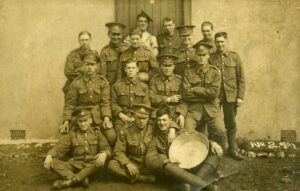
When war began, Lord Kitchener, the Secretary of State for War, believed that overwhelming manpower was the key to winning the war and he set about looking for ways to encourage men of all classes to join. This concept stood in direct contrast to centuries of British military tradition, in which the British Army had always relied on professional (rather than conscript) soldiers, and had drawn its members from either the gentry (for officers) or lower classes (for enlisted men).
On 6 August, Parliament sanctioned an increase in Army strength of 500,000 men; day’s later Lord Kitchener, Minister of War, issued his first call to arms. This was for 100,000 volunteers, aged between 19 and 30, at least 1.6 metres (5’3″) tall and with a chest size greater than 86 cm (34 inches). Fuelled by Patriotism, and a sense of adventure, over a million men had volunteered to fight by the end of 1914. Here is the breakdown:-
- 298,923 men volunteered for the Army in August 1914
- 462,901 volunteered in September
- 136,811 in October
- 169, 862 in November
- 117,860 in December
Recruitment was boosted further by the decision to form the units that became known as “Pals” Battalions. General Henry Rawlinson initially suggested that men would be more willing to join up if they could serve with people they already knew. Lord Derby was the first to test the idea when he announced in late August that he would try to raise a battalion in Liverpool, comprised solely of local men.
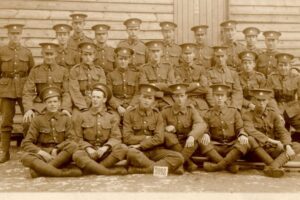
Within days, Liverpool had enlisted enough men to form four battalions, each a 1,000 strong. ‘Pals Battalions’ proved popular elsewhere. Stockbrokers, Miners, Railway workers, sportsmen and artists all formed their own battalions. The “Grimsby Chums” was formed by former schoolboys of Wintringham Secondary School in Grimsby. Many other schools, including some of the leading public schools, also formed battalions. Several sportsmen’s battalions were formed, including three battalions of footballers: 17th and 23rd (Service) Battalions, Middlesex Regiment, and 16th (2nd Edinburgh) (Service) Battalion, Royal Scots, the last-mentioned battalion containing the entire first and reserve team players, several boardroom and staff members, and a sizable contingent of supporters of Scottish professional club Heart of Midlothian F.C. Out of nearly 1,000 battalions raised during the first two years of the war, 145 Service and seventy Reserve infantry units were locally raised Pals battalions. Some Pals battalions were trade/social-background linked rather than area linked, such as artists’ battalions and sportsmen’s battalions. Professional golfers Albert Tingey, Sr., Charles Mayo, and James Bradbeer joined Pals battalions.
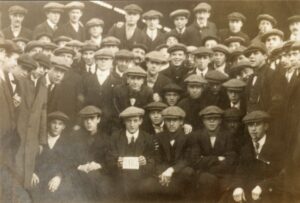
In the first two years of the war, over 3 million men in the UK joined and from the 1,000 new battalions created, nearly a third of the men were locally raised “Pal battalions”. By mid 1916, the whole British Army had turned itself into a Citizen Army – something it had never been before. The 1916 Military Service Act would conscript a further 3.5 million over the next two years. National pride, peer pressure and a desire for adventure with a Pals Battalion were among the reasons for sign-ups, while army pay was also a factor for many.
More than 50 Cities and towns raised their own ‘Pal Battalions’. Hull with a relatively small population raised four Pal battalions. These became known as the “Hull Commercials”, Hull “Tradesmen”, Hull “Sportsmen” and “T’Others”. Liverpool also raised four Pal Battalions, Birmingham and Glasgow had three, and Manchester had seven. Newcastle had two, but had an additional four called the Tyneside Scottish Brigade and another four called the Tyneside Irish Brigade. The bonds of friendship were a major strength in building an effective fighting unit. However, the tragic consequences of this were that heavy casualties could decimate all of the men from the same street, team, or workplace. This became evident on the opening day of the battle of the Somme, where on the 1st July 1916, the many Pal Battalions saw their first action. They experienced 57,000 casualties, with nearly 20,000 killed in a single day. The Battle of the Somme, would last 141 days, during which British casualties amounted to 419,654 Officers and men. Whole towns, villages, neighbourhoods, and communities suddenly found that they had lost great numbers of their young men. The Battle of the Somme marked a turning point in the Pals battalion experiment. Many were disbanded or amalgamated after the scheme effectively came to an end following the summer of 1916.
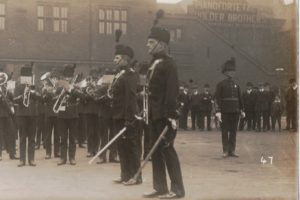
Hull Pals Training and Service
The Hull Pals were initially trained in Hull and Beverley from 6th October 1914 to 16th February, 1915. They moved onto the Dalton Holme Camp from 16th February 1915 to 16th June 1916. This was a large estate owned by Lord Hotham, situated 5 miles, North west of Beverley. They then trained at Ripon Army camp, North Yorkshire, between 18th June 1915 to 28th October 1915 and then at Salisbury, Wiltshire, from 29th October 1915 to 12th December 1915. The Hull Pals Battalions proceeded to Egypt, around the December 11th 1914, to defend the Suez Canal. They travelled by train to Devonport, Plymouth, and embarked on HMT Ausonia, sailing at 12.30pm on December 16th 1915. The Hull Pals then received orders to transfer to France. They arrived in Port Said, Egypt, by train on 29th February 1916 and embarked for France on the HT Simla. They sailed at 6.00am on March 1st, arriving in Marseilles at 11.50pm on March 8th after an ‘uneventful voyage’. Disembarking the following day they left Marseilles by train, on March 10th, bound for Pont Remy, which is 7 miles south east of Abbeville in the Somme region of Northern France. They arrived early in the morning of March 12th. The battalion then undertook a series of route marches to arrive at Colincamps, on the Somme, arriving on 6th April 1916. The battalions then settled into a routine of a few days in the trenches, including repairing them followed by a few days in billets were they trained in ‘bombing, signalling, (barbed) wiring and Lewis gun work’. Between April and June the battalion moved between Colincamps, Courcelles-Aux-Bois and Bus-Les-Artois. They came under heavy bombardment on several occasions during this period. The Hull Pals were lined up in support, for the initial attack at the Somme on 1st July 1916.
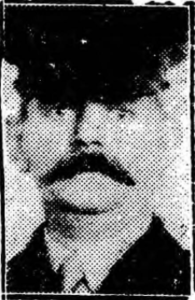
Their assault was fortunately postponed due to other heavy losses earlier in the day and they escaped with relatively few losses on the 1st July 1916. However, on 13th November 1916, the Hull Pals attacked as a combined force, at the village of Serre, near Beaumont Hamel on the Somme. They suffered severe losses on this day, earning Hull’s first Victoria Cross. After resting and regrouping , the Hull Pals were heavily involved in the fighting around Arras, and on the 3rd May 1917, attacked again in force, at the Village of Oppy Wood. It was a largely a diversionary action, but the Germans were heavily defended in the woods and inflicted severe losses on the Hull Pals. After this decimation, the Hull Pals were merged and amalgamated with recruits from other regiments. The original spirit of the Hull Pals was largely diluted, but the the East Yorkshire Service Regiments continued in action and played an important role in delaying the German Spring Offensive in 1918. The 10th Battalion, East Yorkshire Regiment for example, attacked Ploegsteert Wood in a series of actions between September 28th – October 2nd 1918.
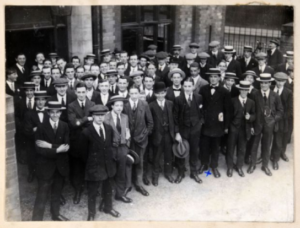
Hi again, I commented about some of the EY regiment photos you posted actually being of the Yorkshire Regiment, true but not very helpful.
I think the Army Museum in York near Cliffords tower has copies of the Snapper, the East Yorks Regiment magazine including the WW1 period.
They might have photos in them of the E. Yorks regiment you could substitute for the Yorkshire Regiment ones.
I find your site generally to be excellent and would like to thank you for all the work done in setting it up for the public to use for research.